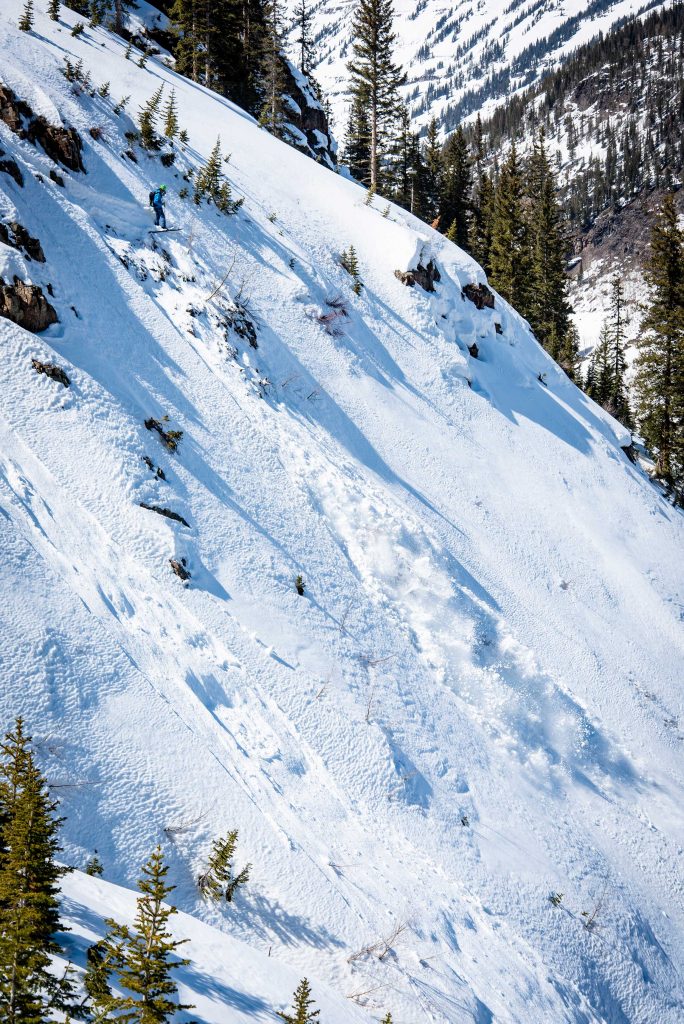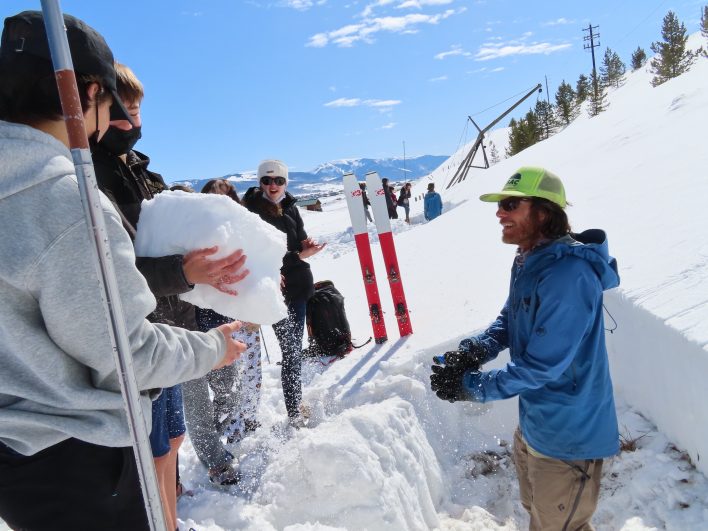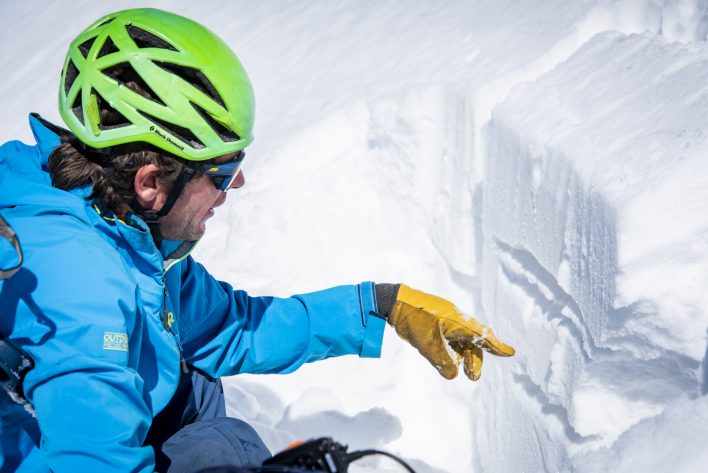It’s mid-morning on a warm Friday in early April, and I’m riding shotgun with Zach Guy, lead forecaster for the Crested Butte Avalanche Center (CBAC). We’re driving to the Kebler Pass winter trailhead near Crested Butte, Colorado, where Guy and fellow CBAC staffer Zach Kinler will venture into the field to assess snow conditions as they wrestle with the question of if/when to bump the area’s avalanche danger rating from moderate to considerable.
“We have a big warm-up coming this weekend,” says Guy, adding that his primary concern is whether the incoming higher temperatures could kick loose a dangerous wet slab avalanche cycle. “Wet slabs are one of the hardest things to forecast for. So we want to get a sense of how far water has moved down into the existing weak layers that we already know are there, which hopefully gives us some indication of how things may react as it heats up.”

The crown of this slide on Schuylkill Ridge, which wiped out trees in its path, dwarfs Zach Guy, even with his pole outstretched. [Photo] Evan Ross
The day’s ski tour is a shuttle-assisted, point-to-point affair, traveling up and over the western flank of Mt. Emmons, connecting Kebler Pass and the Slate River Drainage. Along the way Guy and Kinler will focus on the particularly worrisome zones, digging pits in east, southeast and west aspects below and near tree line.
A skis-on-snow-everyday approach is standard operating procedure for the CBAC, the nonprofit forecasting center that has always focused solely on the Crested Butte area and celebrated its 20th anniversary last year. This is in contrast to larger government-funded forecasting operations, such as the Colorado Avalanche Information Center (CAIC), which provides daily forecasts for 10 zones across the state, but does not have a full-time field presence in its Gunnison zone. That zone includes the smaller area surrounding Crested Butte, which the CBAC forecasts for, meaning each day there are two different (but typically similar) forecasts for the same area.
“We are in [the] field every day but not in all 10 zones,” explains Brian Lazar, deputy director of the CAIC, adding that there’s a certain amount of daily “triage” to determine where field staff resources are allocated and that, in order to produce daily forecasts, the CAIC relies in part on observations from ski patrols, various winter-sports guiding operations and the backcountry-using public at large. The CAIC also maintains a large network of weather stations that produce valuable forecasting data. That information is displayed on the CAIC website, where organizations such as the CBAC can—and do—use it as part of their daily operations.
The Boulder-based CAIC, an agency within the Colorado Department of Natural Resources, also handles highway avalanche safety across the state, a task Lazar says accounts for about half of the organization’s budget and staff time. Most other avalanche centers in the West fall within the U.S. Forest Service, and are only responsible for backcountry forecasting, while the various state departments of transportation handle roadway responsibilities. “Having all the state-employed avalanche forecasters in one shop provides some nice leverage for us,” says Lazar.

In the heat of the afternoon, Guy gauges the size of potential wet slides with a ski cut. [Photo] Nolan Blunck
In contrast, the non-government-affiliated CBAC employs three forecasters who are solely responsible for keeping a close eye on the comparatively small swath of terrain that surrounds this ski town nestled in central Colorado’s Elk Mountains. That narrow focus helps drive the argument that the CBAC’s more localized approach is a better forecasting model—especially in a zone as popular and dynamic as Crested Butte. Snowfall totals often vary widely across the six adjacent drainages within the CBAC forecast area, which was broken into two zones last year in order to provide even more granular information to its users.
“I honestly believe we are delivering a better, more precise, more personable product,” contends Steve Banks, current CBAC board of directors vice president and an internationally certified mountain guide who was part of the original crew that started the CBAC two decades ago. “We believe we have a better handle of what our users are doing in the backcountry and what they need to help them make more informed decisions.”
Perhaps ironically, the CAIC was partly responsible for getting the CBAC off the ground. Back in the early 2000s, the state agency provided avalanche forecasts for just three sprawling Colorado mountain zones (north, central, south). The Crested Butte area, which fell into the central zone, was something of an information vacuum. It also happened to have a small but passionate and increasingly educated backcountry community, including mountain guide and avalanche education instructor Alan Bernholtz.
“It was around 1998 and the CAIC guys had come through town to do an avalanche awareness talk,” recalls Bernholtz. “I was having breakfast with some of their people, and they were like, ‘Crested Butte is a black hole for us. You should start your own center here.’”
Bernholtz, Banks and a few other snow-savvy locals embraced the idea, and by 2001 the CBAC was born, supported in part by a $2,000 donation from the CAIC. “Initially we declined the money,” recalls Bernholtz. “We wanted to be independent and not answer to anyone, but then they called back and basically said, ‘What’s your problem? Take the money and do the right thing.’ So we took the money.”

Forecaster Zach Kinler starts the new generation off on the right foot during a snow science workshop with middle schoolers. [Photo] Zach Kinler
Even with a little seed funding, the CBAC’s early years were spartan. Bernholtz’s windowless, wood-paneled basement served as their base of operations. “There was a Dell computer, a printer, an internet cord; it was all good stuff at the time, but funny to think about now,” he says. “And no one was getting paid much, if anything. It was more of a ‘jobby.’ Sometimes if they’d been out late the night before, guys would sleep in the basement so they wouldn’t miss their forecast shift. Or they’d be doing their laundry while they were working. But we were putting out a forecast seven days a week. That became our motto, ‘We do it every day.’ And we do it only for our little zone, not the entire swath of Colorado’s central mountains.”
Those early forecasts were based more on gut than science, recalls Billy Rankin, another member of the back-then CBAC team. “We would look at weather models and patterns that affected our area,” says Rankin, who figures he forecasted for about seven years. He now runs his own outdoor education consulting business and is the snow safety director for a snowcat skiing operation near Crested Butte. “A lot of what we did back then was just talking to the local guides and ski patrollers and other forecasters and asking, ‘What have you seen out there? What do you think?’” Additionally, the CBAC also tried to draw the public into the conversation by entering anyone who submitted an observation into an end-of-season raffle for a new pair of skis.
Once a consensus was reached, the forecast was posted on the CBAC’s rudimentary website, read live on the local radio station and recorded as a voicemail message so users could call in and listen.
“Other avalanche centers would just say, ‘Stay below 30 degrees,’ but we saw the progression of risk tolerance and knew people wanted to ski the steeps,” adds Rankin. “Our goal was to meet them there and give them real advice, not just a generic ‘avoid everything’ forecast.”
From the beginning, the community embraced the Center, drawn to its less academic, more personalized and often off-beat approach. “We’ve always strived to provide something people could relate to, and not sound like your high school science teacher,” says Banks. “And I’m not trying to knock the CAIC or other large avalanche centers, but there really are huge benefits to being local and flexible.”
The CBAC’s connection to the community has remained strong while the organization has grown significantly. What was once an operation with a $20,000 budget funded in part by a beat-the-dog-to-the-buried-beacon competition has grown into a thriving nonprofit that employs seven staff members and has its own office space, storage area, large screen desktop computer, van, trailer, two snowmobiles, weather station and full suite of avalanche safety equipment for its staff. Nearly half of the CBAC’s funding comes from trusts, donations and sponsorships from a host of local businesses as well as well-known outdoors brands such as Mammut, Flylow, Ortovox and Backcountry Access.
In contrast, most (if not all) federal and state avalanche centers have a “Friends of” nonprofit partner that is their fundraising entity. As governmental agencies, these forecasting centers cannot directly raise outside money.

This comes with pros and cons for both sides, says CBAC development director Karen Williams. “Because the CBAC is all one entity, and does not receive or rely on federal or state funding, we can be more fluid in our approach to the services we offer and access funding to provide those services,” says Williams. “And as a tight-knit group working together—forecasters, board, outreach staff, administrative staff—we are able to work collaboratively to identify needs and move quickly to fund the needs we have identified. This is a huge advantage that prevents the CBAC from bogging down or slowing down in the work needed to accomplish our goals.”
Of course the one large disadvantage to not being federally or state funded is not always having a reliable money flow. “We all sit on eggshells at the beginning of each season while we are assessing the budget, wondering if we are still relevant to our community,” admits Williams. “But so far each year we’ve found that we are relevant and that our community near and far provides the necessary funding that lets us continue to do what we do.”
Indeed, the CBAC’s operating budget has grown from $68,000 in 2016/17 to $205,000 for the upcoming ski season. “We’ve realized what a huge asset our forecasters are,” adds Williams. “And we’ve worked diligently to secure more money for their wages in the hope that they continue to love what they are doing for the Center and that they can make a living here in the winter.”
Guy is exhibit A for this effort. Roundly considered one of the bright minds in today’s avalanche forecasting world, the 36-year-old is in his second stint with the CBAC. He first came to Crested Butte in 2011 fresh off earning a master’s degree in snow science from Montana State University in Bozeman. Initially he worked at the local snowcat operation before hooking up with the CBAC, where he ascended from part-time forecaster to full-time director. But Guy says the job became overwhelming, with duties split between forecasting and fundraising. So in 2016, looking for a new challenge, he left to take the director position at the U.S. Forest Service-run Flathead Avalanche Center in northern Montana. Three years later, he came back to Colorado, this time as the CBAC’s lead forecaster. (Fundraising duties now fall under the purview of the executive director.)
But Guy didn’t come back simply because the job had become easier. “Part of it was love for the community and the lifestyle and the people who live here,” he says. “Part of it was frustration with the bureaucracy that comes from working for the government and getting bogged down on the administration side, meaning less time in the field and working with peers.”

Colorado’s challenging snowpack was also part of the allure. “In Montana the challenge was a lack of data and observations and weather stations,” says Guy, who freely admits he took a significant pay cut to come back to the CBAC. “In Crested Butte you see a lot more action. The snowpack is so wild, especially if you get a winter like last year.”
Indeed, the 2020/21 season was a wild one. According to its recently released annual report, the CBAC documented 658 D2 and 28 D3 avalanches within its forecast area, roughly twice the average annual number of large avalanches in the past five years. The area’s sketchy snowpack—and a steady increase in backcountry users, especially during the 2019/20 Covid season—spurred the CBAC to further increase its educational programming, which included the creation of new outreach director and outreach assistant positions who implemented field-based snow science demonstrations for local middle schoolers, posted up at various trailheads to increase interaction with backcountry users, orchestrated a virtual fireside chat speaker series with experts in the field and produced a half-dozen short educational videos.
“Looking ahead, we’re trying to secure funding for an avalanche training park that would be open to the public,” says Ian Havlick, a longtime CBAC forecaster who slid over to the outreach director role last season. Many major ski resorts have such parks on mountain, meaning a lift ticket is required for access. “If we can raise the needed funds (about $5,000), it’ll be readily available to the public,” Halvick continues, adding that the park would be located next to the town’s K-12 community school and that he feels it’s important for local kids to get at least some avalanche education. “In a lot of places avalanches are more theoretical for kids. They happen over there. But here we have avalanche terrain that’s literally right out the back door.”
And while it’s impossible to know for sure, the array of outreach efforts along with daily forecasts appear to have had the desired effect. Last February was Colorado’s deadliest month of the season with seven fatalities, but according to the CBAC’s annual report the Crested Butte zone saw only one reported human-triggered avalanche and no public involvements.
“I would like to think that the work we do makes us all safer,” says CBAC forecaster Evan Ross. “It feels like even though we have a lot of people going into the backcountry here, Crested Butte has fewer overall accidents and has seen fewer deaths than other places. How much of that is the Center versus the education level of [the] public? Yeah, we probably do have a more educated public. But maybe that comes from the outreach the Center does, and maybe there’s a circle that comes around.”
Again it’s tough to pinpoint cause and effect, but there’s no denying the Crested Butte community’s level of engagement, especially when it comes to submitting observations. Guy claims the Crested Butte zone regularly leads the state in number of observations submitted. “Maybe it’s because we have more terrain, so there isn’t this fierce competition to ski powder,” he adds. “Whatever it is, it just feels like the community is looking out for each other.”

Avalanche center staff take their outreach straight to the people, interacting with hundreds of backcountry users at trailheads throughout the season. [Photo] Zach Kinler
And that helps everyone, including the CAIC, which has a daily, early morning Skype call with the CBAC team to discuss current conditions and deliberate about which danger rating, avalanche problems and travel advice belong in the daily forecasts issued by both agencies.
“Of course there is some downside in that you have two groups spending money on essentially the same things in an industry that’s not exactly flush with cash,” says the CAIC’s Lazar. “But they are covering their area very well, doing highly professional work, and that gives us the opportunity to refocus some of our resources to other areas because we don’t need to do as much field work there.”
Back in the field, Guy, Kinler, photographer Nolan Blunck and I make our way up and over the shoulder of Mt. Emmons, dropping into north-facing Redwell Basin. Initially the snow is creamy soft, making for some sweet springtime turns. But lower down things start to get wet and heavy, prompting Guy to direct us to a safe zone on a north-facing slope while he inches out over a rock outcrop along the top of an adjacent northeasterly face. With a few stomps and a well-placed ski cut, Guy manages to kick free a decent-sized wet, loose avalanche that gouges through most of the dwindling snowpack. The soupy slide, which he calls a D1.5, produces enough debris to catch and bury a skier.
Fortunately that didn’t happen, nor did we see a true wet slab avalanche, and 30 minutes later we arrive safely at the Slate River winter trailhead, kick off skis and boots, then climb into my car to complete the day’s shuttling.
What’s the day’s takeaway, I ask Guy.
“Part of it was validating today’s forecast, which I think we did,” he says. “Part was looking ahead to what we’re worried about over the next couple days, trying to get a sense of where, when and why the wet slab problem could develop. It’s always hard to exactly pin that down, but my impression is that, for now, it’s not super scary out there.”
But, Guys adds, they’ll keep monitoring things daily, just as the Crested Butte Avalanche Center has done for the last 20 years.
Jason Sumner is a longtime outdoor sportswriter who lives in Crested Butte, Colorado.
This article was originally published in Issue #141. Snag a copy here or subscribe.










Related posts: